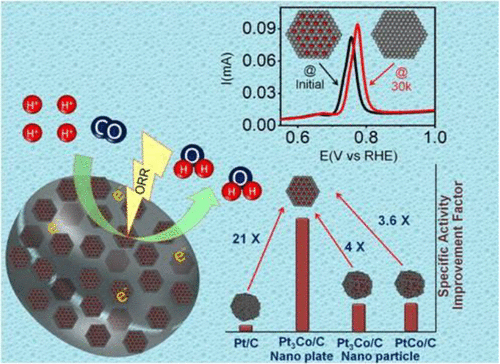当前位置:
X-MOL 学术
›
ACS Sustain. Chem. Eng.
›
论文详情
Our official English website, www.x-mol.net, welcomes your
feedback! (Note: you will need to create a separate account there.)
Molten-Salt Synthesis of Pt3Co Binary Alloy Nanoplates as Excellent and Durable Electrocatalysts toward Oxygen Electroreduction
ACS Sustainable Chemistry & Engineering ( IF 7.1 ) Pub Date : 2020-01-07 , DOI: 10.1021/acssuschemeng.9b05650
Moorthi Lokanathan , Indrajit M. Patil , Prateekshita Mukherjee , Anita Swami , Bhalchandra Kakade
ACS Sustainable Chemistry & Engineering ( IF 7.1 ) Pub Date : 2020-01-07 , DOI: 10.1021/acssuschemeng.9b05650
Moorthi Lokanathan , Indrajit M. Patil , Prateekshita Mukherjee , Anita Swami , Bhalchandra Kakade

|
Although Pt3M (M = transition metals such as Co, Ni, Cu) binary alloy nanostructures have been well established with reference to their unique composition (chemically ordered) and electrocatalytic property relationship, further improvement in their catalytic efficiency could be possible by tuning the surface properties. Herein, to improve the sluggish kinetics of electroreduction of oxygen, we demonstrate an effective way to prepare carbon-supported Pt3M nanostructures, especially Pt3Co using a single-step, molten-salt synthesis (MSS) method, without using any capping or stabilizing agent. X-ray powder diffraction (XRD) studies confirm alloy formation in Pt3Co with a face-centered cubic (fcc) structure (but surprisingly not a chemically ordered structure or L12 phase) and transmission electron microscopy (TEM) reveals the formation of hexagonal nanoplates with approximately 2 nm thickness and ∼17 nm diameter. The specific geometry and facets (surface properties) are responsible for boosting the specific activity to 4.2 mA cmPt–2, which is almost 21 times greater than that of the state-of-the-art Pt/C catalyst and even superior to those of the Pt3Ni/C and Pt3Cu/C catalysts (prepared by a similar process). Moreover, an increase in the electrocatalytic activity is observed during the durability test that is perceptible due to the formation of Pt-surface segregation and Pt-skin after slight dissolution of transition-metal atoms from the surface, which is also confirmed using a QCO/2QH indicator ratio.
中文翻译:

Pt 3 Co二元合金纳米板的熔盐合成作为优良且耐用的电催化氧还原反应
尽管已经根据其独特的组成(化学有序)和电催化特性关系很好地建立了Pt 3 M(M =过渡金属,例如Co,Ni,Cu)二元合金纳米结构,但通过调节,可以进一步提高其催化效率表面特性。本文中,为了改善氧气电还原反应的缓慢动力学,我们演示了一种有效的方法,该方法使用一步熔融盐合成(MSS)方法制备碳载Pt 3 M纳米结构,尤其是Pt 3 Co,而无需使用任何封端或稳定剂。X射线粉末衍射(XRD)研究证实了Pt 3中的合金形成具有面心立方(fcc)结构(但出人意料的不是化学有序结构或L 12相)的Co和透射电子显微镜(TEM)揭示了六边形纳米板的形成,其厚度约为2 nm,直径约为17 nm。特定的几何形状和刻面(表面性质)有助于将比活度提高到4.2 mA cm Pt –2,这几乎是最新的Pt / C催化剂的21倍,甚至优于那些Pt 3 Ni / C和Pt 3的含量Cu / C催化剂(通过类似方法制备)。此外,在耐久性试验期间观察到电催化活性的增加,这是由于过渡金属原子从表面轻微溶解后形成的Pt表面偏析和Pt皮肤引起的,这也是可以用Q CO证实的。/ 2 Q H指标比率。
更新日期:2020-01-07
中文翻译:

Pt 3 Co二元合金纳米板的熔盐合成作为优良且耐用的电催化氧还原反应
尽管已经根据其独特的组成(化学有序)和电催化特性关系很好地建立了Pt 3 M(M =过渡金属,例如Co,Ni,Cu)二元合金纳米结构,但通过调节,可以进一步提高其催化效率表面特性。本文中,为了改善氧气电还原反应的缓慢动力学,我们演示了一种有效的方法,该方法使用一步熔融盐合成(MSS)方法制备碳载Pt 3 M纳米结构,尤其是Pt 3 Co,而无需使用任何封端或稳定剂。X射线粉末衍射(XRD)研究证实了Pt 3中的合金形成具有面心立方(fcc)结构(但出人意料的不是化学有序结构或L 12相)的Co和透射电子显微镜(TEM)揭示了六边形纳米板的形成,其厚度约为2 nm,直径约为17 nm。特定的几何形状和刻面(表面性质)有助于将比活度提高到4.2 mA cm Pt –2,这几乎是最新的Pt / C催化剂的21倍,甚至优于那些Pt 3 Ni / C和Pt 3的含量Cu / C催化剂(通过类似方法制备)。此外,在耐久性试验期间观察到电催化活性的增加,这是由于过渡金属原子从表面轻微溶解后形成的Pt表面偏析和Pt皮肤引起的,这也是可以用Q CO证实的。/ 2 Q H指标比率。

































 京公网安备 11010802027423号
京公网安备 11010802027423号